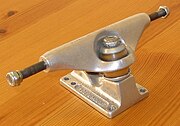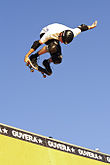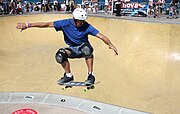skateboard
A skateboard [ skeɪtbɔːɹd ], occasionally Germanized also skateboard called, is a board (cover) with two axles (trucks) and four rollers (wheels) on which to stand particularly, by pushing off from the ground with one leg (pushing) or by means of a Technique of alternating pressure on both feet to the outside of the skateboard (diagonally to across the direction of travel) by skillfully shifting weight (pumping). The skateboard is rarely used purely as a means of transportation. Rather, skateboarding has developed over the decades into a sport with a rich repertoire of tricks and its own terminology. The tricks mostly consist of jumps with the skateboard and are often performed in combination with turning the skateboard and the body.
Construction of the skateboard
The board of a skateboard ( deck ) is a wood from the group of veneer plywood , usually seven-ply and made of Canadian or Baltic maple . Its dimensions are usually about 80 centimeters in length and 20 centimeters in width. Two movably mounted axles are screwed to the underside, which is often graphically elaborately designed.
Such an axle ( truck ) consists of two main components: the lower part ( baseplate ), which is attached to the board with four screws ( mounting, bolts, shorties ), and the upper part ( hanger ), which consists of two ball-bearing wheels Polyurethane plastic carries. Both parts are connected by a main screw ( kingpin ) and two bushings ( bushings, rubbers, dohdohs ). The skateboard can be steered by shifting your weight thanks to the axles, which are movably mounted around a pivot point . To better hold the rider on the skateboard, a mostly black, self-adhesive sandpaper ( griptape ) is glued to the top (step surface). Today's skateboards have an upwardly curved part protruding over the axles at the front and back. The protruding area of the board is called the tail , the front nose . Furthermore, most of the more professional boards nowadays have a slight inward curvature ( concave ).
In addition to the widespread form of the skateboard described above, there are other variants. The most important are longboards and slalom boards. Longboards have a longer deck, larger and softer wheels, and a less pronounced nose and tail . Slalom skateboards are often made of flexibly swinging wood and often without any protrusion at the nose and tail. Snakeboards are two-part skateboards. They are used for both slalom riding and tricks.
Components of a normal skateboard are:
- Axle nuts
- Wheels and bearings are attached to the axle with these nuts
- Baseplate
- Base plate of the axis. This securely connects the axle and deck with mounting screws.
- Bearing
- Ball bearings, 2 per role, so 8 for the entire board. They are available in different quality. The precision of the bearings is specified in ABEC and ranges from ABEC 1 to ABEC 11.
- Bolts, shorties
- Mounting screws. This is used to screw the axles and the deck.
- Bushings, DohDohs, Rubbers
- Bushings made of polyurethane. They sit between the hanger and the baseplate and are available in different degrees of hardness.
- deck
- The actual board of the skateboard. They are available in different designs and sizes.
- Grip tape
- Rough, non-slip covering that is glued to the deck. He ensures the hold on the board. Available in different designs and different grain sizes.
- Hanger
- Part of the axle to which the rollers are attached. The hanger is moveable to enable steering.
- Kingpin
- This screw is used to hold the parts of the axle together and adjust the hardness of the steering.
- Nose
- Curved tip of the deck, which is used for many tricks.
- Nuts
- Nuts of the mounting screws.
- (Shock) pad
- Plastic or rubber plate that can be screwed between the deck and the baseplate. As a result, the deck is higher (riser pad) and is dampened.
- Spacer
- Spacer sleeves between the two bearings of an axle.
- Tail
- High curved end of the deck. Requirement for many tricks.
- Trucks
- Complete axle connected to the deck and the wheels, consists of a baseplate, hanger, bushing and kingpin.
- Wheel
- Rollers or wheels of the skateboard. They are available in different hardnesses (in A) and diameters (in mm). Hardness levels between 95 and 100 A and diameters between 50 and 60 mm are common.
Disciplines of skateboarding and skateboarding tricks
Culture of skateboarding
Skateboarding can hardly be compared to conventional sports. There is a lack of leagues or associations that divide sport into municipal, national or international hierarchies. And yet organizations take care of the existence of a worldwide network for the implementation of loose competitions such as the "Mastership", a kind of world championship, the X Games in California or regular so-called "Contests". There is the “World Cup of Skateboarding” and in Germany the “Club of Skaters”. In the context of these contests there are actually ranking lists of international skateboarders. However, in the self-image of many skaters, skating is viewed more as an individualized expression of life - sometimes also as a kind of art - than as a sport. The experiences of conflict and criminalization that often arise from the use and “appropriation” of public space, the first origins of skating in the “dropout mentality of surfers” and the creativity demanded have rooted skating subculturally to this day . There is a certain connection between fashion and the fine arts such as graffiti , graphic design and photography or various music scenes. For example, varieties of punk and hardcore music that are closely related to skateboarding culture are sometimes also referred to as skate punk .
Because of the largely missing organizational structure, its deliberately unregulated character and the mostly young people practicing it, skateboarding is often counted as one of the so-called recreational sports . However, in addition to its subcultural connections, the continuity of skateboarding, which has been practiced for decades, speaks against this classification. In addition, the complexity of sport places high demands on perseverance and willingness to learn, which is contrary to the character of fast-paced and fast-moving trend sports .
For a long time, skateboarding was predominantly male-dominated. However, more and more women have found interest in this sport in recent years. Professional female skateboarders such as Elissa Steamer have a role model function. The skateboard industry, especially in the area of clothing and shoes, is adapting to this development and is now designing fashion especially for young women.
Rules and legal
According to 24 para. 1 of the Road Traffic Regulations (StVO), the skateboard is not a vehicle, but a means of transport on the same legal basis as a wheelchair and a toboggan. In Germany, the road traffic regulations for pedestrians apply to such means of transport. It follows that skateboards may not be used on the road, as they are reserved for vehicles according to Section 2, Paragraph 1 of the StVO. Furthermore, the use of skateboards on bike paths is prohibited, as the same regulations apply to skateboarders as to pedestrians in traffic areas. So when skateboarding you are obliged to use the sidewalk.
The same applies in Austria according to the StVO : sidewalks, pedestrian zones as well as residential and play streets may be used in accordance with the law. In fact, especially at times (e.g. in the evening) and in areas with little car traffic, there is little local traffic on boards (short to long, rarely snake and wave boards) and inline skates on various lanes, especially when sidewalks are next to them safe rolling are too narrow or uneven. By clearly avoiding the legally privileged car traffic, for example walking on the sidewalk and convincing submission in the event of a complaint by police officers, being punished can be avoided in most cases. Facilities such as halfpipes and pools generate a certain amount of all-round and feeder traffic. Individual skateboarders rarely join events such as Friday night skating in Vienna or Graz, and only for one piece, but the organizers do not want them to be on the safe side.
Organizers usually require helmets to be worn and, in most cases, protective equipment for hands, elbows and knees.
History of skateboarding
The origin of modern skateboarding, formerly also called "asphalt surfer", lies in the 1960s and arose through the transfer of surfing to asphalt and concrete. It developed into a trend sport that was mainly practiced by young people. There were also championships that included downhill slalom , obstacle course and freestyle on a flat plain. However, due to other burgeoning trends, the sport quickly lost its importance and by the end of the decade it was even difficult to even get a skateboard.
The replacement of the previously used rolls made of baked clay with those made of polyurethane meant a major technical advance with better adhesion and rolling properties.
The construction of the rubber-buffered axle bearing, which enables steering by shifting your weight to the side on the board and resets itself to straight ahead, is still in use today. This suspension was later used on the front of the skatebike and other hybrids, the alternative steering mechanisms of snake and wave boards did not reach Europe until around 2005/2010.
These technical developments revived the sport as they made new maneuvers possible. The pioneer of today's skateboarding culture was the Zephyr team from Dogtown , a district of Venice Beach in California . This group consisted of passionate surfers who gave skateboarding a new face in the 1970s through the stylistic transfer of their hobbies to the street. One of the disciplines they developed themselves was particularly groundbreaking, pool riding , which was the birth of the Vert Style and is continued today in the form of the halfpipe. Tony Alva , who came from the team, soon became the first skateboard world champion and had a lasting impact on the scene and public perception with his style.
The first boards were ridden in Austria in the mid-1970s.
In the early 1990s, the shape of the normal street skateboard changed to a slimmer, almost front-back symmetrical cut with almost equally long protrusions on the nose and tail. This construction method and the movements and leverage that it enabled enabled new forms of tricks to be performed.
In terms of its construction, the skateboard now seems to be fully developed: attempts with new materials such as boards made of aluminum , carbon layers or kevlar and various axle techniques for longboards have not been successful. In the past few decades there have been several phases in which skating has enjoyed great popularity. They were superseded by periods when the sport lost many of its supporters. The IOC decided on August 4, 2016 that skateboarding would be an Olympic sport from 2020 .
Regular print and video publications as well as websites with blogs and discussion forums are an important means of communication in the scene.
Philatelic
On May 7, 2020, the first day of issue, Deutsche Post AG issued a special surcharge postage stamp with a face value of 95 + 45 euro cents in the series For the sport for the new Olympic sport of skateboarding . The design comes from the graphic artist Thomas Serres from Hattingen .
Professional skateboarders
A professional skateboarding scene has developed particularly in the USA. Professional skateboarders receive payments in cash and in kind through sponsorship agreements with one or more companies (mostly manufacturers of skateboards, companies in the clothing industry or skateboard shops). A well-known example of this are the popular skateboarders Tony Hawk , Danny Way , Bam Margera , Jamie Thomas , Chris Cole , Rob Dyrdek , Mike Vallely , Eric Koston , Paul Rodriguez Jr. , Ryan Sheckler and Rodney Mullen . But European skaters like the Vans driver Chris Pfanner or the German Mack McKelton are also successful in the contests.
Jargon / glossary
See main article: Skateboarder Jargon
Well-known skater films
- Mid90’s (2018)
- This Ain't California (2012)
- Paranoid Park (2007)
- Dogtown Boys (2005)
- Grind - Sex, Boards & Rock'n'Roll (2003)
- Dogtown & Z-Boys (2001)
- CKY (1999-2003)
- Video Days (1991)
- Gleaming the Cube (1989)
- Thrashin ' (1986)
See also
literature
- Iain Borden: Skateboarding, space and the city: architecture and the body . Berg, Oxford et al. a. 2001, ISBN 1-85973-493-6 / ISBN 1-85973-488-X (English).
- Titus Dittmann, Christian Ambach: Skateboarding Basics, Tricks and Tips. 1st edition, Pietsch, Stuttgart 2009, ISBN 978-3-613-50606-0 .
- Holger von Krosigk, Helge Tscharn: Absolute Beginners: Skateboard Streetstyle Book. Tropen-Verlag, Cologne 2000, ISBN 3-932170-42-3 .
- Holger von Krosigk, Helge Tscharn: Elements of Street: Skateboard Streetstyle Book 2nd 4th edition, Tropen-Verlag, Stuttgart 2011, ISBN 9783608500660 .
- Holger von Krosigk, Helge Tscharn: Everything about skateboarding: history, basics, tricks, material. Tropen-Verlag, Berlin 2006, ISBN 9783932170935 .
- Pit Lederle, Ralph Kenke: roles: photos, addresses, scrolling boards , stories, interviews, lyrics, poems. 1st edition, Hannibal, Höfen 2004, ISBN 3-85445-239-X .
- Günter Mokulys: Flatland skateboard book. Sir Marshall Verlag, Cologne 2004, ISBN 3-00-012548-5 .
- Günter Mokulys: Street skating & Game of SKATE. (English-Deutsch) Sir Marshall Verlag, Berlin 2008, ISBN 3-00-015615-1 .
- D : Federal Ministry of Transport and Digital Infrastructure: StVO as of September 1, 2009: Section 2 (1) , Section 24 (1) and Section 25 (1)
- A : StVO for roller skating: § 9, § 17, § 88, in particular: § 88a; Section 94d. Consolidated on an ongoing basis: Federal Chancellery Austria - Legal Information System .
Individual evidence
- ↑ Sharon M. Hannon: Punks: A Guide to an American Subculture. Greenwood Press, Santa Barbara (Calif.) 2010, ISBN 0-313-36456-7 , p. 164 ( online ).
- ↑ Dogtown & Z-Boys , 2001, documentary.
- ↑ Archive link ( Memento of the original dated November 7, 2015 in the Internet Archive ) Info: The archive link was inserted automatically and has not yet been checked. Please check the original and archive link according to the instructions and then remove this notice. Great Moments 1977 (video), Austria's first skateboarders, orf.at, November 2, 2015, accessed on November 4, 2015.
- ↑ "Long Night of the Magazines", November 6, 2015, 0.05 am ORF2 - TV program ORF2, November 6, 2015.
- ^ IOC approves five new Olympic sports . spiegel.de. Retrieved September 6, 2016.
Web links
- Danny Kringiel: Legendary Skateboard Heroes . The board in your head . On: spiegel.de - Spiegel Online - one day , July 27, 2010; last accessed on May 12, 2014.
- Skateboard assembly instructions . On: oldschool.de ; last accessed on May 12, 2014.
- scientific description of skateboard culture ( memento from February 22, 2008 in the Internet Archive )
- Perfect tricks in the video from several angles ( Memento from December 28, 2008 in the Internet Archive )
- The history of skateboarding ( Memento from October 28, 2012 in the Internet Archive )











